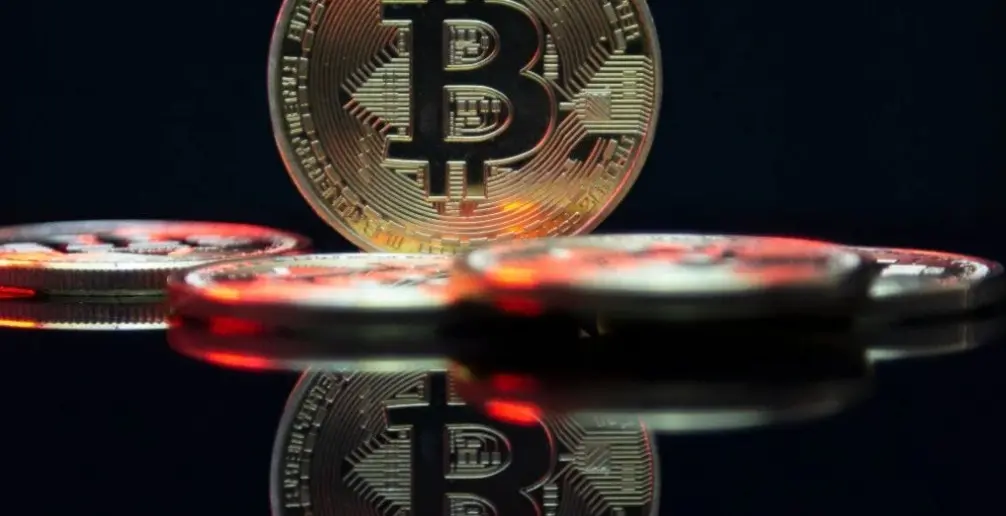Galaxy Digital: Bitcoin Halving, Bullish or Bearish?
Original Title: Bitcoin Halving: Digital Scarcity in Action
Original Authors: Alex Thorn, Gabe Parker, Simrit Dhinsa, Galaxy
Original Compilation: Lynn, MarsBit
Overview of Bitcoin Halving
The transparency and predictability of Bitcoin issuance are key features that distinguish this asset from any other asset or currency in the world. No other asset has a calculable inflation schedule, and foreseeable supply events can reduce the daily issuance by 50% overnight. Bitcoin's anonymous creator, Satoshi Nakamoto, programmed the halving feature of Bitcoin as a countermeasure against the continuous devaluation of fiat currency.
"The fundamental problem with traditional currency is all the trust that’s required to make it work. The central bank must be trusted not to debase the currency, but the history of fiat currencies is full of breaches of that trust." - Satoshi Nakamoto, February 11, 2009
On April 20, 2024, Bitcoin will undergo its fourth halving at block number 840,000. During each halving event, the block reward (also known as the "block subsidy")—which represents the amount of newly issued Bitcoin paid to miners for each mined block—will be cut in half. After the fourth halving, the block reward will decrease from 6.25 BTC to 3.125 BTC (equating to a daily reduction from approximately 900 BTC to about 450 BTC). Consequently, Bitcoin's annual issuance rate will drop from about 1.7% to approximately 0.85%. According to Coin Metrics, by the time of the fourth halving, 93.7% of Bitcoin's total supply will be in circulation.
Halvings occur every 210,000 blocks (approximately every four years), and after the fourth halving, the network will experience 30 more halvings. Halving is expected to continue until the last Bitcoin is mined, which is anticipated to happen sometime after 2140. Once all Bitcoins are mined and in circulation, miners will no longer receive block subsidies and will rely entirely on transaction fees and other forms of off-chain payments.
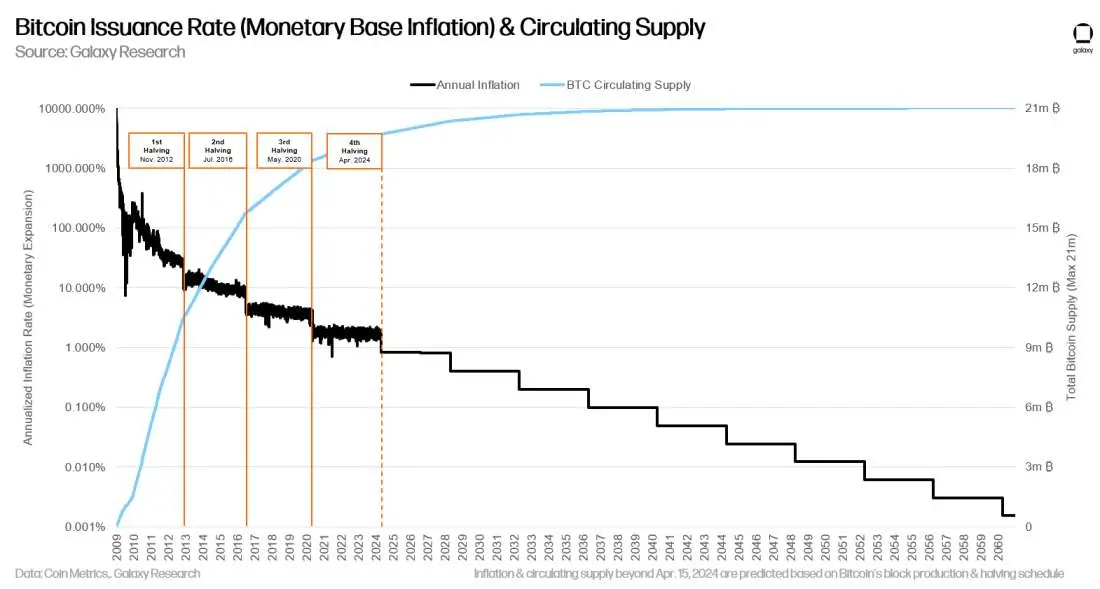
Bitcoin is designed to reduce its issuance approximately every four years, which is a pillar of its transparent and predictable monetary policy, making Bitcoin a provably scarce asset. Most importantly, Bitcoin's monetary policy is enforced by immutable code that is agreed upon by network stakeholders (miners, nodes, developers). The scarcity of Bitcoin and the predictability of its monetary policy stand in stark contrast to the significant devaluation of world fiat currencies, which has also earned Bitcoin the well-known nickname of "digital gold."
Visualizing Bitcoin Core Halving
Bitcoin Core is the open-source software created by Satoshi Nakamoto that underpins the Bitcoin protocol. Bitcoin Core is considered by developers to be the primary reference implementation of Bitcoin (although other software implementations are compatible with the network). Therefore, all the functions and logic that define Bitcoin exist within Bitcoin Core.
The code that enforces halving in Bitcoin Core consists of 7 lines of C++ code. A line-by-line breakdown of the code is beyond the scope of this report; however, the code that visualizes the block reward based on the current block height is very important:
- Line 1240: Calculates how many halvings have already occurred.
- Lines 1245 - 1248: Determines the miner's block reward.
Understanding Bitcoin Mining
Mining is a key component of the Bitcoin network. When someone wants to send Bitcoin to another wallet, the transaction is first broadcast to the network and checked for validity by nodes. Before being added to a block, the transaction exists in a queued state within the "mempool," which is a pool of unconfirmed transactions waiting for miners to include them in a block. The block subsidy serves both as an incentive for miners to contribute computational power to the network to process and settle transactions and as a method for distributing the newly minted Bitcoin supply. As the price of Bitcoin rises, the motivation to mine blocks for these rewards also significantly increases.
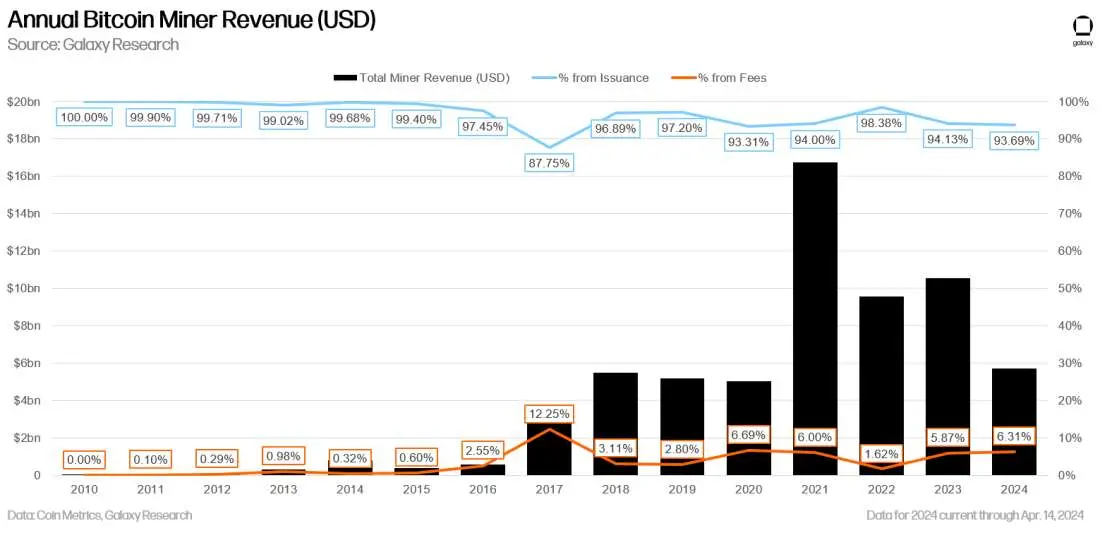
Miners produce blocks by calculating the correct hash value for the next block. With this advantage, miners with the highest hash rates or computational power from Application-Specific Integrated Circuit (ASIC) machines will have the highest probability of finding the hash for the next block. The first miner to compute the correct hash value will receive the block subsidy and the transaction fees from the block. Typically, the time to compute the correct hash value is about 10 minutes (the block time for Bitcoin). The network guarantees miners that the block time will always be around 10 minutes through difficulty adjustments. These adjustments occur every 2016 blocks (approximately every two weeks) as the network hash rate increases or decreases. The greater the hash power, the higher the difficulty of mining blocks. Thus, difficulty adjustments enforce consistent block production and Bitcoin's monetary policy.
By convention, the first transaction in a block is a special transaction that initiates the new coins owned by the block creator. This increases the incentive for nodes to support the network and provides a method for initially distributing coins into circulation, as there is no central authority to issue them. The steady increase of a certain number of new coins is similar to gold miners consuming resources to add gold to circulation. "In our case, the consumed resources are CPU time and electricity." - Satoshi Nakamoto, Bitcoin White Paper, October 31, 2008
The Impact of Halving on Bitcoin Mining
Bitcoin miner rewards consist of block subsidies and transaction fees. During a halving, the Bitcoin block subsidy will be halved from 6.25 BTC to 3.125 BTC. Assuming Bitcoin prices and network hash power remain unchanged, this will result in Bitcoin miners' income being nearly cut in half, as the block subsidy currently constitutes the majority of total rewards.
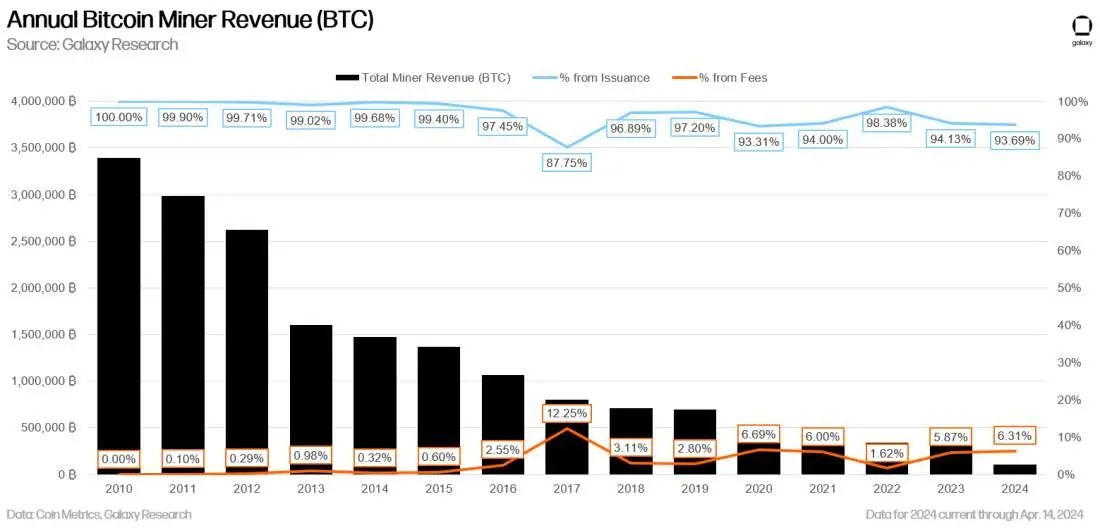
For miners, this means that the same amount of computational power will yield about half of what it did before the halving event. Therefore, after the halving, the cost of mining a single Bitcoin is expected to roughly double, making it unprofitable for less efficient miners, who will be forced to cease operations. As a result, network hash power is expected to decline in the short term. Hash power refers to the total computational power that miners contribute to Bitcoin. The severity of the decline in network hash power will depend on factors such as Bitcoin prices and transaction fees at the time of the halving.
The table below outlines the expected costs of mining one Bitcoin under different power cost scenarios after the halving, using various commonly used ASICs (listed from lowest efficiency to highest efficiency). These calculations assume a network hash rate of 625 EH and that transaction fees account for 10% of the block reward.
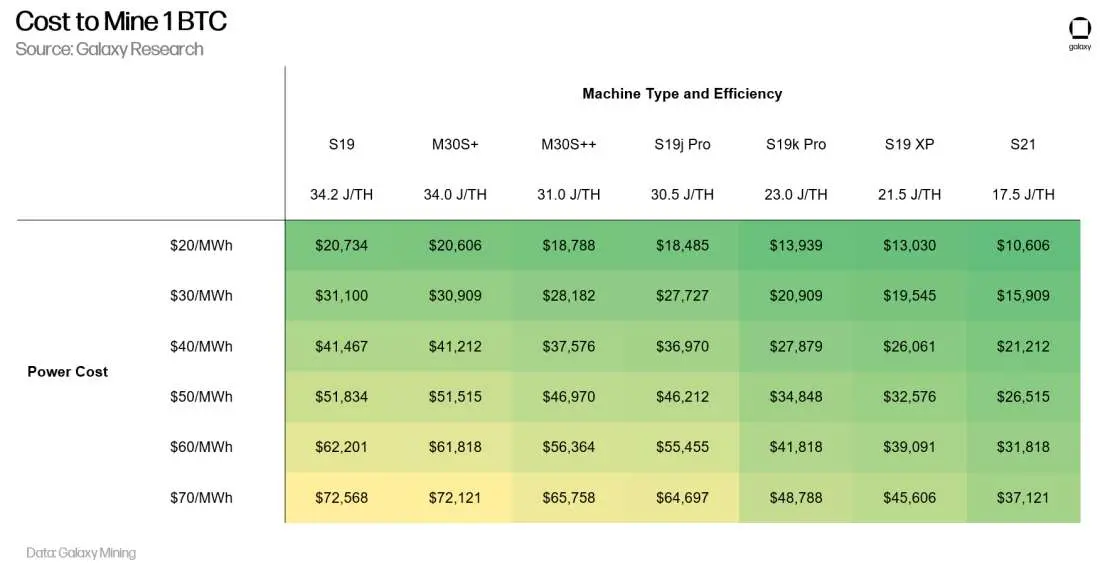
To prepare for the halving, miners have been working to improve operational efficiency by reducing costs and upgrading equipment. Many miners have announced large ASIC procurement orders and strategic site acquisitions to position themselves favorably before the halving. As highlighted in the table above, at a power cost of $50/MWh, the mining cost of the S21 is 50% cheaper than that of the S19, illustrating the importance of improving fleet efficiency.
Before the halving, miners have increased their cash reserves, maintaining a large cash reserve as "dry powder" to take advantage of discounted infrastructure purchases in case Bitcoin prices rise. A surge in merger and acquisition activity is expected after the halving, as assets will shift to more efficient operators, consolidating the industry landscape and driving further optimization.
Overall, the upcoming Bitcoin halving represents a critical moment for miners. As the industry prepares for a significant reduction in block rewards, miners face an urgent need to adapt and innovate to maintain profitability and sustainability in a changing environment.
The Impact of Halving on Bitcoin Prices
The impact of halving on Bitcoin prices is a continuing debate that occurs with each halving. While historically, market participants have viewed halving as a bullish event for Bitcoin prices, opposing viewpoints argue that the impact of halving on prices can be negligible. Below is a breakdown of the current market views on the impact of halving on BTC prices, categorized as bullish, bearish, and neutral.
Bullish View: The 50% reduction in Bitcoin block rewards makes Bitcoin as an asset overall scarcer while reducing the absolute amount of miner sell-offs. Miners have long been considered forced sellers of Bitcoin, as these operations are capital-intensive, and Bitcoin sales are the primary source of income for miners. Therefore, miners always sell a portion of their block rewards for fiat currency to cover operational costs such as energy, labor, debt, and new machines. Many believe that after the halvings in November 2012, July 2016, and May 2020, the corresponding reduction in supply due to decreased selling pressure from the mining sector led to an increase in Bitcoin's value, and a similar situation may occur after the fourth halving. Market participants who view halving as a bullish sentiment also use the widely circulated stock-to-flow model to quantify the impact of reduced Bitcoin supply on prices. Proponents of this view generally believe that investors have not adequately considered the halving in the current Bitcoin valuation.
Bearish View: With Bitcoin prices historically close to all-time highs, market participants who view halving as a bearish sentiment believe that the market has already adjusted to the first three halvings and has priced in this event. Prior to the last two halvings, BTC fell by more than 42% from previous all-time highs. In fact, at the current stage of Bitcoin's supply schedule, the bull markets of 2017 and 2020 have not yet begun. The impact of each halving on Bitcoin's supply dynamics will inevitably decrease, and the effect will diminish over time. For example, in absolute terms, a reduction from 900 BTC issued daily to 450 BTC is much smaller than a reduction from 7,200 BTC to 3,600 BTC (the first halving). Considering that the current daily issuance of 900 BTC is negligible compared to the asset's daily circulation, the impact of a post-halving daily issuance of 450 BTC on BTC prices is minimal. Additionally, bears argue that the reduction in miner income could lead to chaos in the mining industry and reduce the security of the Bitcoin network.
Neutral View: The efficient market hypothesis suggests that past and future halvings of Bitcoin, contrary to "new information," cannot be viewed as supply shocks. The transparency of Bitcoin's issuance schedule should always be reflected in the market. Bull markets following halvings may be more related to changes in demand rather than changes in supply, and may even be more related to factors such as global market liquidity, central bank interest rates, and other macro conditions.
Historically, Bitcoin has entered bull markets during the hype phase following halvings, which lasts from 0 to 600 days. After the first halving in 2012 (Cycle 1), Bitcoin's price reached its cycle peak 367 days after the halving. During the second halving in 2016 (Cycle 2), the price discovery post-halving was slower, reaching its cycle peak 525 days after the halving. The third halving in 2020 (Cycle 3) reached its cycle peak 546 days after the halving.
If history repeats itself, we are currently at the tail end of the accumulation phase and will gradually enter the hype phase sometime in 2024.
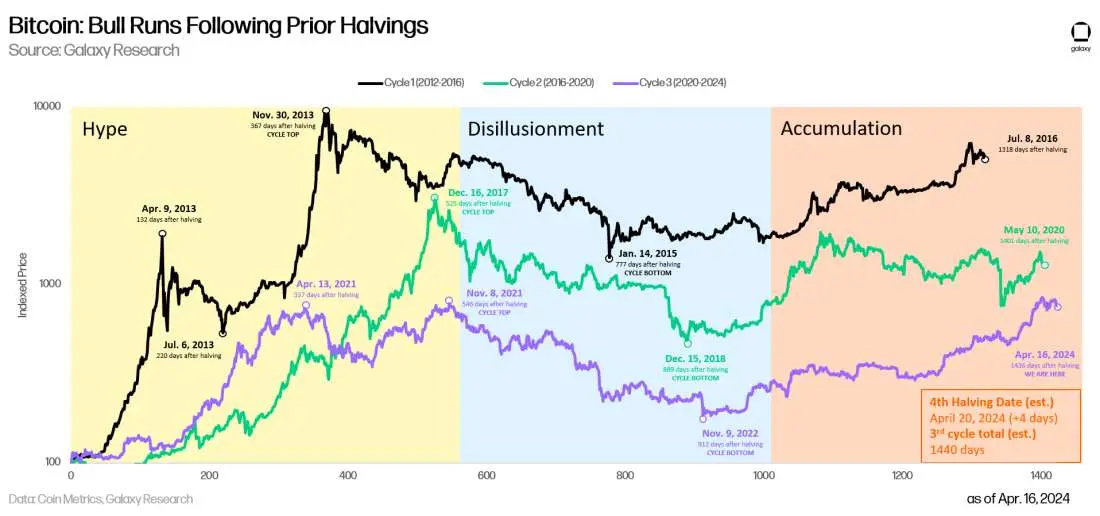
Bitcoin prices have surpassed the historical highs prior to the halving for the first time. During the first two halvings in 2016 and 2020, Bitcoin prices fell by 42.5% and 52.8%, respectively, from previous all-time highs. While the strong price movement of Bitcoin before the halving can be seen as the market leading up to the hype phase we typically see post-halving, the driving force behind Bitcoin prices in this cycle is new developments that were not present in previous halving cycles, particularly the launch of the Bitcoin ETF in the U.S. in January 2023 based on spot trading.

The fourth Bitcoin halving will occur at a time when the asset is undergoing a significant paradigm shift following the launch of the spot Bitcoin ETF. Since the ETF's launch on January 10, 2024, net inflows into BTC spot ETFs have exceeded $12.5 billion. Bitcoin has re-emerged at the forefront of macro investor discussions and is now viewed as a key macro hedge asset alongside gold and government bonds. The emergence of Bitcoin ETFs in the U.S. represents a monumental shift that will disrupt traditional notions regarding Bitcoin price cycles, holder behavior assessments, and the dynamics of internal rotations within cryptocurrencies.
Block Activity Halving
Block number 840,000, also known as the halving block, will become a highly sought-after block for transactions due to its historical significance and rarity. Halvings occur every 210,000 blocks, and there will only be 34 halving blocks in the existence of Bitcoin, leading to fierce competition among users and miners to transact or mine blocks within this block.
Core factors driving the surge in transaction fees during the halving include the launch of a new fungible token standard called Runes, as well as the rarity of sat hunting. Runes are a new fungible token standard for Bitcoin, more efficient than the BRC-20 token standard. Runes will launch on the halving block, and a large number of Rune token collections are expected to pay high transaction fee rates to ensure they are included in that block. For more information about Runes, we will provide a more detailed overview of the new fungible token standard in the Galaxy Research newsletter. For reference, a sat is the smallest unit of Bitcoin—one Bitcoin can be divided into 100 million sats. Rare sats are a new collectible asset on Bitcoin, created when Ordinals emerged in December 2023. Collecting rare sats requires purchasing sats mined in historically significant blocks, such as halving blocks or blocks mined by Satoshi Nakamoto (block 9). Each sat in block 840,000 will hold significant historical value, and thus rare sat hunters will charge high fees in their transactions to ensure inclusion in the block.
Another potential factor driving up transaction fees during the halving is whether mining pools attempt to reorganize (restructure) the historical state of Bitcoin's blockchain. Reorganization occurs when an alternative version of the blockchain gains consensus among nodes, effectively rewriting part of the blockchain's transaction history. Although the chances of a successful reorganization are slim, mining pools may attempt to reorganize the chain to successfully capture blocks with high fees. It is worth noting that mining pools that attempt to reorganize the chain but fail will still push up transaction fees, as the computational power used for the reorganization is being diverted from the tip of the longest chain. This will slow down block times and naturally lead to increased fees, as the mempool pressure has more time to accumulate.
Why Halving is Important
Halving embodies Bitcoin's transparent, predictable, and deflationary monetary policy. Halving events reinforce Bitcoin's fundamental value proposition, including its open peer-to-peer network, competitive mining industry, decentralized node network, and active open-source development community. Halving itself is the mechanism that distinguishes Bitcoin's scarcity from other assets.
Bitcoin's immutable monetary policy, combined with a hard cap of 21 million, is a revolutionary concept for macro assets. The transparency of Bitcoin's daily issuance schedule allows anyone in the world with a computer to independently verify whether Bitcoin is being issued as planned, without relying on or trusting intermediaries. Additionally, every node in the Bitcoin network can confirm that the hard cap supply of 21 million remains intact.
The predictability and transparency of Bitcoin's fixed supply make this emerging asset a viable alternative store of value to fiat currencies. Unlike Bitcoin's fixed supply, fiat currencies are subject to the discretionary actions of central banks, which have the authority to adjust the money supply to manage economic stability or stimulate growth. This discretion leads to an unlimited total supply of all fiat currencies, and their issuance schedules are unpredictable. The impact of this unpredictability is evident when evaluating central bank actions. In response to the global economic turmoil caused by the COVID-19 pandemic, the Federal Reserve printed $5 trillion out of thin air, more than doubling its balance sheet. This money printing, combined with U.S. government fiscal spending, permeated the U.S. economy to help mitigate the negative impacts of lockdowns and COVID-19 measures and stimulate the economy, but ultimately led to the most severe inflation in decades. Even gold, often hailed as the oldest scarce monetary asset, lacks a clear total supply, and while its output is influenced by market dynamics rather than central bank policy decisions, it remains unpredictable.
Bitcoin's resilience during numerous bear markets highlights its value as a decentralized macro asset with transparency, predictability, and scarcity, reigniting interest in the broader market. Bitcoin's monetary policy is fixed, and each halving reaffirms its longevity. Halvings will continue to occur, and stakeholders will never be bailed out by the system. The halving expected on April 20, 2024, will reinforce these facts and remind the market of Bitcoin's unique attributes.
"If you don’t believe me or don’t understand, I don’t have time to try to convince you, sorry." - Satoshi Nakamoto, July 29, 2010




